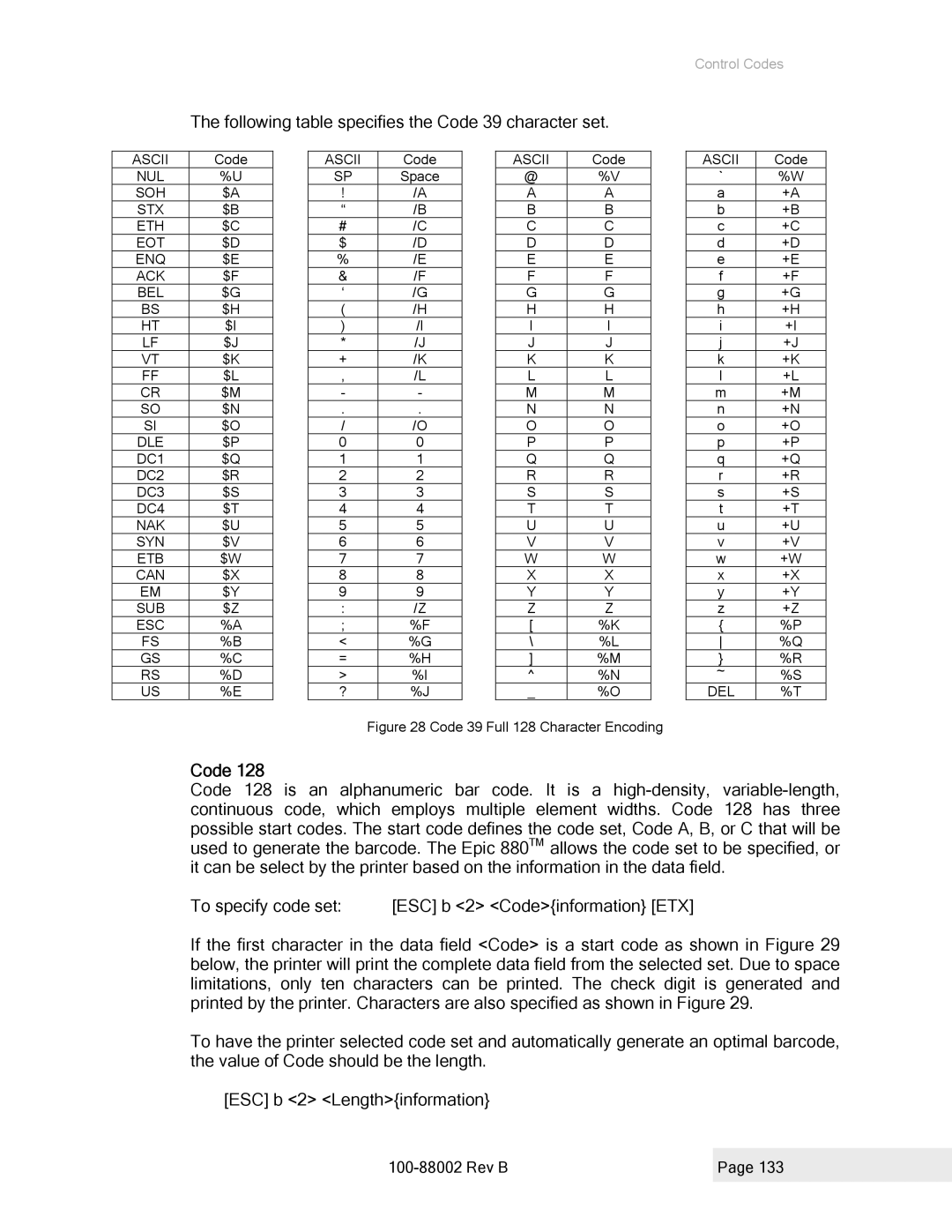
Control Codes
The following table specifies the Code 39 character set.
ASCII | Code |
NUL | %U |
SOH | $A |
STX | $B |
ETH | $C |
EOT | $D |
ENQ | $E |
ACK | $F |
BEL | $G |
BS | $H |
HT | $I |
LF | $J |
VT | $K |
FF | $L |
CR | $M |
SO | $N |
SI | $O |
DLE | $P |
DC1 | $Q |
DC2 | $R |
DC3 | $S |
DC4 | $T |
NAK | $U |
SYN | $V |
ETB | $W |
CAN | $X |
EM | $Y |
SUB | $Z |
ESC | %A |
FS | %B |
GS | %C |
RS | %D |
US | %E |
ASCII | Code |
SP | Space |
! | /A |
“ | /B |
# | /C |
$ | /D |
% | /E |
& | /F |
‘ | /G |
( | /H |
) | /I |
* | /J |
+ | /K |
, | /L |
- | - |
. | . |
/ | /O |
0 | 0 |
1 | 1 |
2 | 2 |
3 | 3 |
4 | 4 |
5 | 5 |
6 | 6 |
7 | 7 |
8 | 8 |
9 | 9 |
: | /Z |
; | %F |
< | %G |
= | %H |
> | %I |
? | %J |
ASCII
@
A
B
C
D
E
F
G
H
I
J
K
L
M
N
O
P
Q
R
S
T
U
V
W
X
Y
Z
[
\
]
^
_
Code
%V
A
B
C
D
E
F
G
H
I
J
K
L
M
N
O
P
Q
R
S
T
U
V
W
X
Y
Z
%K
%L
%M
%N
%O
ASCII | Code |
` | %W |
a | +A |
b | +B |
c | +C |
d | +D |
e | +E |
f | +F |
g | +G |
h | +H |
i | +I |
j | +J |
k | +K |
l | +L |
m | +M |
n | +N |
o | +O |
p | +P |
q | +Q |
r | +R |
s | +S |
t | +T |
u | +U |
v | +V |
w | +W |
x | +X |
y | +Y |
z | +Z |
{ | %P |
%Q | |
} | %R |
~ | %S |
DEL | %T |
Figure 28 Code 39 Full 128 Character Encoding
Code 128
Code 128 is an alphanumeric bar code. It is a
To specify code set: | [ESC] b <2> <Code>{information} [ETX] |
If the first character in the data field <Code> is a start code as shown in Figure 29 below, the printer will print the complete data field from the selected set. Due to space limitations, only ten characters can be printed. The check digit is generated and printed by the printer. Characters are also specified as shown in Figure 29.
To have the printer selected code set and automatically generate an optimal barcode, the value of Code should be the length.
[ESC] b <2> <Length>{information}
| Page 133 |
|
|
